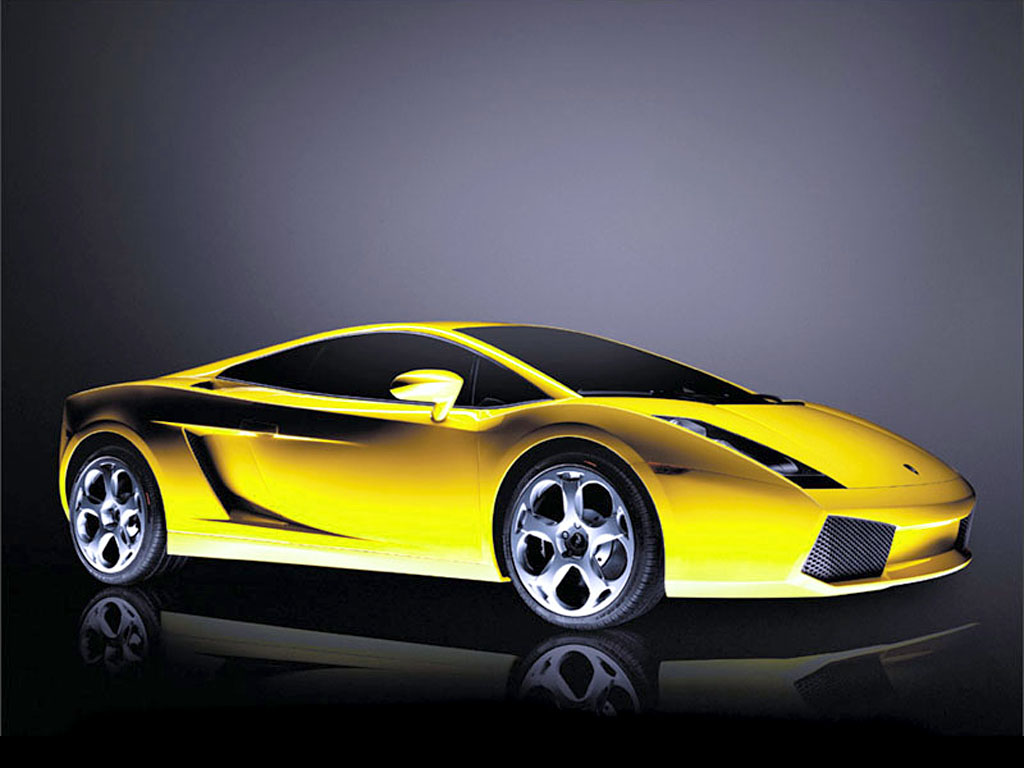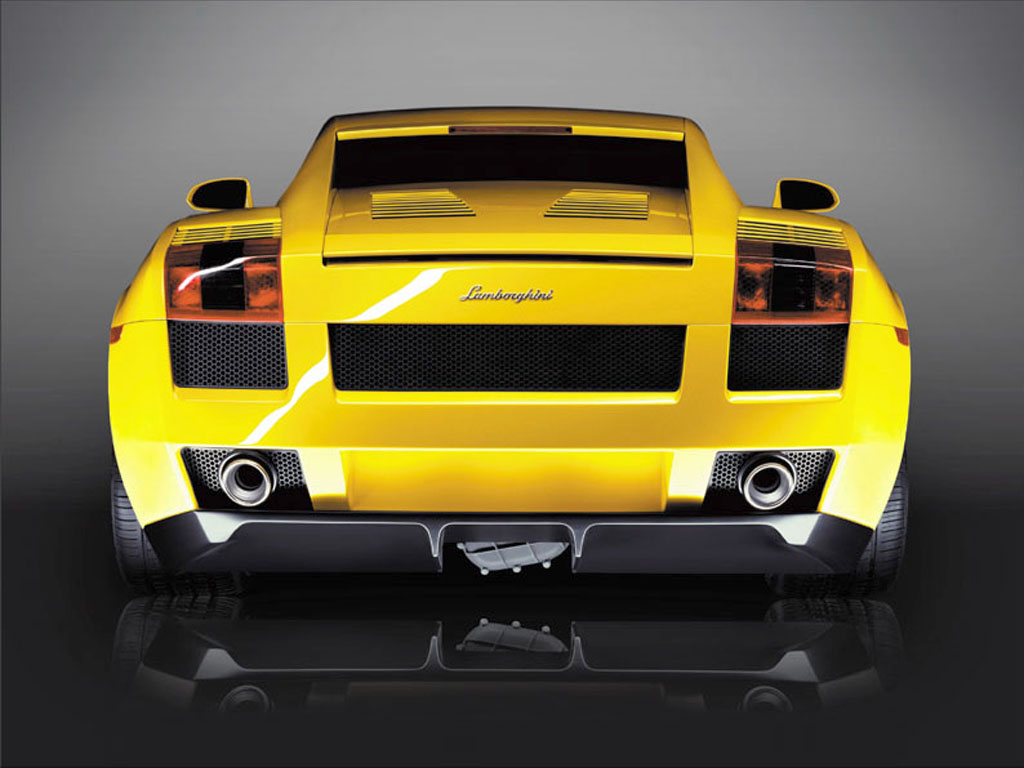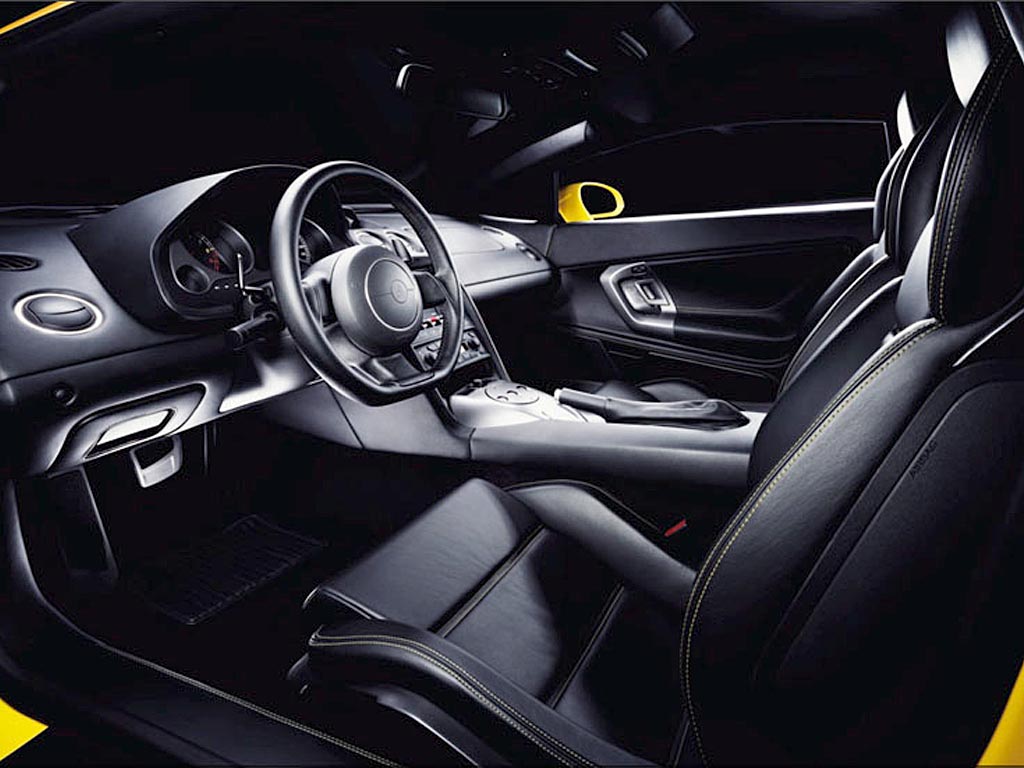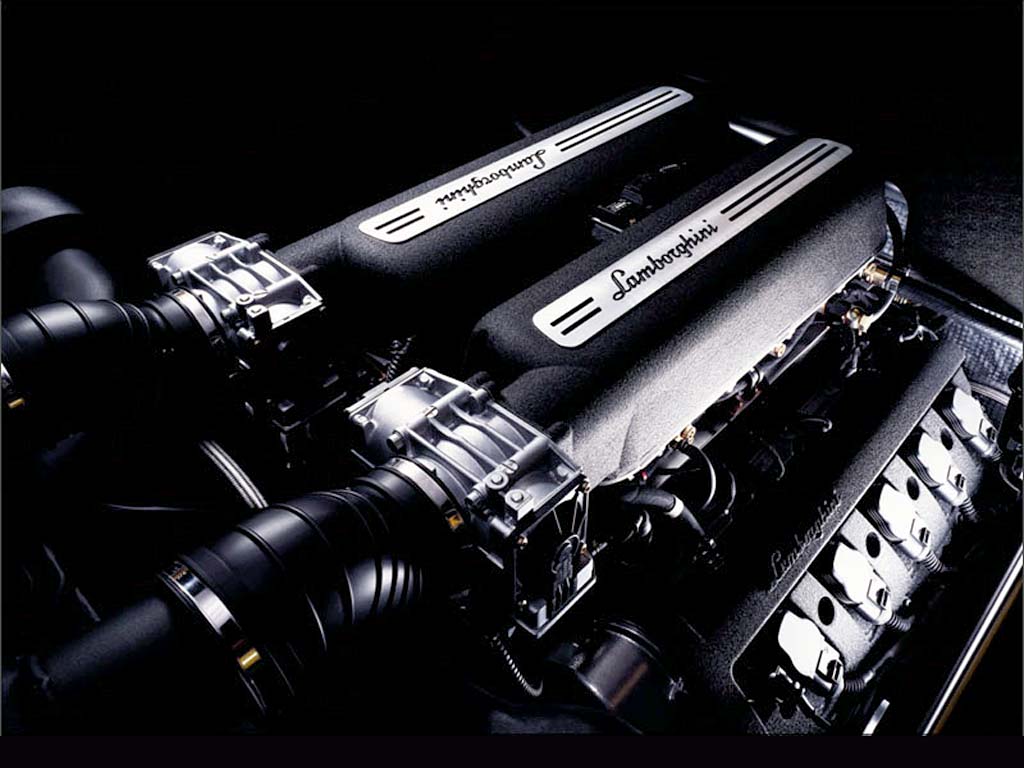2003 Lamborghini Gallardo
Honouring their tradition, the Lamborghini decided to release their next model with the name of a fighting bull’s breed: the Gallardo.
The Concept
Designed to redefine its segment as the best high performance sports car and driving behaviour that fits its driver in every situation. The Gallardo is the synthesis of a true sports car that can be used on an every day basis. While matching these two apparently conflicting objectives, the guideline for Lamborghini engineers has been to fulfil the necessary comfort requirements without any compromise in the performances expected of a true Lamborghini car.
The choices for engine, transmission, space frame and body, suspensions, brakes and electronics are then all in line with such an objective. The result is a compact (length 4.3 m) 2-seater high performance car (maximum speed well over 300 km/h), that can be driven with pleasure both on race tracks and on long distance journeys on country and city roads.
The design
The Gallardo design vision was initiated in the year 2000.
Its design, based on an Italdesign-Giugiaro style proposal was developed by the Lamborghini Centro Stile to incorporate the parameters of our extreme design philosophy. The Gallardo dimensions combined with the competitive performance targets ensure the car an athletic compactness. The long wheelbase complemented by short overhangs dynamise its appearance.
The cab-forward cockpit integrated in the body by a strongly slanted front screen and tensed pillars, the complex surfacing intersected by crisp graphics and its cooling flow oriented detailing evokes as in the Lamborghini tradition in its proportions and formal language a strong aeronautical influence.
From the very beginning and in coherence with the defined layout, the design phase was completely integrated in the project development. Thus, a complete matching between style requirements and functional requirements has been reached, avoiding style elements without functional basis or functional parts with poor visual appearance.
The Engine
The Lamborghini V10 cylinder DOHC four valve V90 5 liter, 500 Hp, 510 Nm, is the concept solution for the high performance Gallardo.
Instead of the more classical choice of a V72, an angle of 90 degrees was preferred in order to limit the height of the engine with advantages in the car layout (e.g. lower engine bonnet and better rear view) and in the lowering of the centre of gravity (i.e. better car dynamic characteristics). Even firing intervals (that ensure the smoothness of the engine) are guaranteed by the adoption of crankpins incorporating an 18-degree offset.
A dry sump lubrication system not only achieves the correct lubrication even in extreme dynamic conditions, but also permits the centre of gravity to be lowered further.
The torque output is optimised in the full rpm range. In order to achieve such an objective, the charge efficiency was increased at various speeds by a precise utilization of gas dynamic effects that take place in the intake and exhaust system. These effects are managed by the adoption of a variable geometry intake manifold and of a continuously variable valve timing system, both for intake and exhaust.
While the variable geometry (which can be defined as variable length) guarantees the correct base gas dynamic characteristics both at low rpm (long runners) and high rpm (short runners), the variable valve timing system guarantees the most suitable valve opening and closing moments for each rpm. For instance, the intake valve closing moment is anticipated at low rpm and retarded at high rpm in order to coincide with the positive peaks of the pressure pulsations at the intake valves.
Thus, the maximum torque of 510 Nm is reached at 4500 rpm, with 80% of this maximum already achieved at only 1500 rpm; conversely, the maximum power is obtained at a much higher speed, i.e. 7800 rpm. The throttle control is performed via a Drive by Wire system, with two electronic throttle bodies. The construction technology is obviously all aluminium.
The transmission
The main feature is the permanent four-wheel drive transmission, based on the well-proven Lamborghini Viscous Traction system. Such a system, which at constant speed on homogenous adhesion roads presents a traction force distribution around 30% front, 70% rear, is conceived to be self-regulating, without the necessity of electronic controls. Indeed, thanks to the chosen characteristics of the viscous coupling, an intrinsic regulating closed loop operates in all conditions, varying the traction force distribution as a function of the dynamic weight distribution variations and of the adherence conditions.
Thus, during acceleration (or during climbing) on high adherence roads, the distribution will change favouring the rear axle (more rear traction force percentage, e.g. 80%, corresponding to the increased weight on the rear axle). However, if in these conditions the rear axle tends to lose adherence, more traction is immediately biased to the front, with the system tending to reach a point where the adhesions utilized by the two axles are identical.
A robotized sequential gear shifting system, the Lamborghini e-gear, has also been developed, maintaining the basic mechanical gearbox unchanged. The main features of this system, available as an option, are:
-electronic control, interfaced via CAN bus to the engine control system and the ESP system
-actuation by paddles directly mounted on the steering column
-possibility to select different operating modes: normal, sport, automatic, low adherence
-very fast but smooth shifting, equal to or better than that which is achievable by a very good driver with a standard gearbox
The rear differential features a friction-type 45% limited slip, while the front differential slip limitation is controlled by the ABD (automatic brake differential) function of the ESP system.
The clutch is a reduced diameter double plate clutch. This is logical consequence of the Gallardos engineering car concept definition, in order to keep the engine (and consequently the centre of gravity) as low as possible.
Space Frame and Body
Together with the perfect definition of suspension, weight distribution, centre of gravity and aerodynamic characteristics, the achievement of high body stiffness is fundamental to obtain optimal car dynamics and driving enjoyment even on long trips.
For the Gallardo Lamborghini engineers have chosen to utilize the aluminium technology developed by AUDI, world leader in this field.
The final solution results in a structural aluminium space frame, based on aluminium-extruded parts welded to aluminium cast joint elements. On this structural frame, the exterior aluminium body parts are mounted by differentiated systems (rivets or screws or welding) depending on the function of the part. Other external hang-on parts (such as the bumpers) are made of thermoplastic material and connected by bolts.
Suspensions and Brakes
Suspensions and Brakes
The choice of double wishbones front and rear suspension system, true to Lamborghini engineering tradition and a must for high performance sports cars, has been confirmed also for the Gallardo.
The accurate definition of the geometry, of the characteristics of springs and stabilizing bars and the adoption of Koni selfadjusting FSD dampers have been fundamental in achieving the desired handling, high speed stability and comfort performances.
Great attention was given to optimising the Gallardos dynamic behaviour in curve. In order to guarantee the best car controllability, the dynamics are slightly under steering at the beginning of the curve and neutral for all the rest of the curve. No wind-up effects (typical of some 4WD cars with viscous transmission) are detectable, even in sharp cornering.
The Pirelli Pzero tires (front 235/35 ZR19, rear 295730 ZR19) guarantee optimal adherence characteristics in the various driving conditions. As an option winter tires with the same dimensions have been developed and will be available next fall.
The choice of 19” wheels has permitted the installation of large diameter brake disks (front 365mm, rear 335) together with Brembo 8-piston callipers in the front and 4-piston callipers in the rear.
Such a braking system, which also features a state of the art ABS/ESP system, guarantees excellent brake efficiency (deceleration over 1.1 g on dry) and the absence of fading phenomenon also after extreme use. The full stability control system (ESP) has been conceived and calibrated in order to assist the driver in demanding conditions, while still allowing a true sports driving experience.
Performance
The high engine power and torque output permit a top speed of 309 km/h and high acceleration capabilities. This top speed is reached guaranteeing an excellent car stability and controllability.
Indeed, in addition to the optimisation of the suspension characteristics, a must was the definition of the correct aerodynamic features, by concentrating not only on the reduction of the drag coefficient, but, even more important, on the control of the front and rear lift coefficients. Such a study lead to important aerodynamic body refinements (e.g. front flap, flat bottom) and to the implementation of a rear spoiler, electronically controlled as a function of the vehicle speed.
In Detail
| submitted by | Richard Owen |
| type | Series Production Car |
| built at | Italy |
| price $ | $ 166,000 |
| engine | 90 Degree, Aluminum V10. |
| position | Mid Longitudinal |
| aspiration | Natural |
| valvetrain | DOHC, 4 Valves per Cyl w/Variable Intake System & Continuously Varibale Valve Timing |
| fuel feed | Multipoint Sequential Fuel Injection |
| displacement | 4961 cc / 302.7 in³ |
| bore | 82.5 mm / 3.25 in |
| stroke | 92.8 mm / 3.65 in |
| compression | 11.0:1 |
| power | 372.9 kw / 500 bhp @ 7800 rpm |
| specific output | 100.79 bhp per litre |
| bhp/weight | 340.14 bhp per tonne |
| torque | 510 nm / 376.2 ft lbs @ 4500 rpm |
| redline | 8100 |
| body / frame | Aluminum & Thermoplastic over Aluminum Spaceframe |
| driven wheels | 4WD w/Viscous Traction System |
| front tires | Pirelli Pzero 235/35 ZR 19 |
| rear tires | Pirelli Pzero 295/30 ZR 19 |
| front brakes | Vented Discs w/Brembro 8-Piston Calipers, ABS |
| rear brakes | Vented Discs w/Brembro 8-Piston Calipers, ABS |
| front wheels | F 48.3 x 21.6 cm / 19 x 8.5 in |
| rear wheels | R 48.3 x 27.9 cm / 19 x 11 in |
| steering | Rack & Pinion w/Power Assist |
| f suspension | Double Wishbones w/Anti-Roll Bar |
| r suspension | Double Wishbones w/Anti-Roll Bar |
| curb weight | 1470 kg / 3241 lbs |
| wheelbase | 2560 mm / 100.8 in |
| front track | 1622 mm / 63.9 in |
| rear track | 1592 mm / 62.7 in |
| length | 4300 mm / 169.3 in |
| width | 1900 mm / 74.8 in |
| height | 1165 mm / 45.9 in |
| transmission | 6-Speed Manual w/Optional Robotized E-Gear |
| gear ratios | 2.563:1, 1.850:1, 1.423:1, 1.138:1, 0.939:1 |
| final drive | 3.077:1 |
| top speed | ~309 kph / 192.0 mph |
| 0 – 60 mph | ~4.1 seconds |
| 0 – 100 mph | ~9.0 seconds |
| 0 – 1/4 mile | ~12.2 seconds |
Auction Results
2006 Lamborghini Gallardo – sold for $115,000 – Highly original. Rare 6-speed manual transmission with overdrive. Special order color that only comes on Lamborghini Murcielago and not on Gallardo. Only 3,500 miles. CD changer stereo. Navigation. All-wheel drive. Steering wheel mounted controls. Heated seats. Anti-theft security. One owner vehicle. Original title. Extra key.
Auction Source: Kissimmee 2014, #WhereTheCarsAre by Mecum












